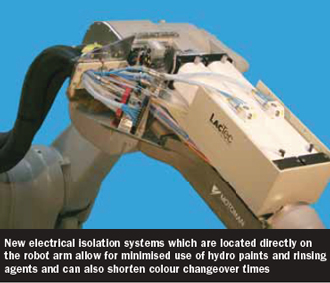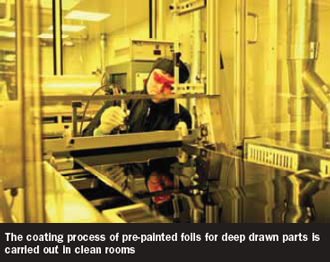Paint trends in the automotive industry

Suppliers of industrial painting technology are offering exciting innovative solutions to the challenges facing OEMs. The spectrum ranges from pre-treatment, equipment and application technology and paint systems, right on up pre-painted foils for component manufacturing. Whether compact cars or luxury limousines, colour and paint provide the vehicle with an appearance that promotes brand recognition and thus good sales figures. And much more: strong, long-lasting resistance to unavoidable mechanical, chemical and physical “attacks” during the car’s service life is absolutely essential. At the same time, global competition necessitates an ever more efficient, sustainable painting process.
A balancing act, one in which the paint industry is continuously working on the improvement of existing options and the development of new ones.
Conservation of resources in pre-treatment
 In order to provide bodies in white and metallic car parts with effective corrosion protection and ideal paint adhesion, they are given conventional zinc phosphating during pretreatment.
In order to provide bodies in white and metallic car parts with effective corrosion protection and ideal paint adhesion, they are given conventional zinc phosphating during pretreatment.
However, phosphating processes which involve the use of heavy metals are being replaced to an ever greater extent by nano-ceramic processes. This trend is based on the ecological and economic advantages of these technologies, which are compatible with a multitude of metals: The products are free of heavy metals which significantly reduces the costs and effort associated with wastewater treatment, disposal, equipment cleaning and system maintenance. Furthermore, the coating can be applied before liquid painting or powder coating by means of an immersion or spray technique at room temperature. This results in further cost reductions. New technologies such as CO2 snow-jet cleaning are displacing conventional power washers more and more frequently for the pre-treatment of attachment parts and interior components made of plastic. On the one hand, this is due to savings amounting to as much as 50% for investment costs, 20% for operating costs and up to 80% for floor space requirements. Also, such compact systems are easy to integrate into the painting line.
Painting with fewer process steps
Filler-free painting systems are on the rise all over the world in the field of vehicle painting – in the premium segment as well as for smaller, cheaper models. The function of the filler coat is usually fulfilled for this so-called integrated concept by a water-based paint system. In comparison with conventional painting processes, this makes it possible to reduce energy consumption by 15% to 20%, by eliminating the intermediate drying process. At the same time, the filler-free painting process reduces solvent emissions and eliminates the need for the system’s filler application section. In the meantime, these economic and environmental advantages have triggered a trend towards a 2-coat finish without primer for coating plastic attachment parts. Solutions for injection moulded interior parts such as trim strips are already available which provide the components with a fine, high gloss finish using just a single coat painting process.
Only as much paint as necessary
 In order to realise potential savings in the painting process, possible causes of loss such as atomiser over-spray must be eradicated, as well as losses due to colour changeovers, during application and in the paint supply lines. Savings of this sort can often be implemented quickly and in a targeted fashion by modifying specific system characteristics. One approach involves increasing transfer efficiency by using a spray pattern that is matched to the geometry of the part to be painted, as well as electrostatically supported paint guns and high-speed rotary atomizers. Transfer efficiencies of greater than 90% are achieved with the latter.
In order to realise potential savings in the painting process, possible causes of loss such as atomiser over-spray must be eradicated, as well as losses due to colour changeovers, during application and in the paint supply lines. Savings of this sort can often be implemented quickly and in a targeted fashion by modifying specific system characteristics. One approach involves increasing transfer efficiency by using a spray pattern that is matched to the geometry of the part to be painted, as well as electrostatically supported paint guns and high-speed rotary atomizers. Transfer efficiencies of greater than 90% are achieved with the latter.
Where hydro paints are concerned, new electrical isolation systems which are located directly on the robot arm are also making a contribution in this respect. They allow for minimised use of rinsing agents and shortened colour changeover times as well. Beyond this, the fine atomisation patterns achieved with electrostatic high-speed rotary atomizers open up the possibility of reducing air sinking speed in the booth, which results in energy savings.
 The increasing degree of automation through the use of robots, for interior painting of auto bodies as well, is also leading to reduced paint consumption. Further advantages include improved reproducibility of painting results and less scrap. Another positive side effect of using painting robots is the fact that it’s easier to switch from fresh exhaust air systems to recirculating air for conditioning the paint booth. This can result in energy savings amounting to 60% to 70%.
The increasing degree of automation through the use of robots, for interior painting of auto bodies as well, is also leading to reduced paint consumption. Further advantages include improved reproducibility of painting results and less scrap. Another positive side effect of using painting robots is the fact that it’s easier to switch from fresh exhaust air systems to recirculating air for conditioning the paint booth. This can result in energy savings amounting to 60% to 70%.
Intelligent paint logistics also result in reduced material consumption. For example, pipe-clearing technology makes it possible to recover unused paint from the feed lines and to dose defined quantities of paint to the application equipment for special paint coatings.
PaintExpo covers the entire process sequence in the field of coating technology and offers a comprehensive overview of the latest developments in the areas of liquid painting, powder coatings and coil coating, as well as paints and pre-treatment. Nearly all renowned suppliers will participate at the leading international trade fair for industrial coating technology.
Comprehensive, representative offerings will allow visitors to gather detailed information in a targeted fashion, and to make direct comparisons of various systems and processes at a single location. PaintExpo will take place at the exhibition centre in Karlsruhe, Germany, from the 17th through the 20th of April, 2012. Prior to this event, FairFair GmbH will promote PaintExpo Eurasia in Istanbul, Turkey, from 6 through 8 October 2011 in cooperation with Artkim Fuarcilik, Turkish specialist for paint and chemical trade fairs
 Mat clear lacquers are in fashion. Robust, easy to care for and relatively UV tolerant, they are currently providing highly individual finishes, particularly on small series production vehicles. One of the focal points of high-gloss clear lacquers is increased scratch-resistance, which extends the new car effect. Innovative developments are available in this area, which combine the advantages of “hard” inorganic substances and “soft” organic substances. In the meantime, a nano solgel process is also being used for mass production by Tier suppliers. This is applied to high-gloss anodised, decorative aluminium parts in order to give them a transparent protective coating which is highly resistant to scratching. Further applications for sol-gel technology are currently being tested by the automotive industry. The significance of UV paints in the automotive industry continues to grow as well – for painting plastic as well as metal substrates.
Mat clear lacquers are in fashion. Robust, easy to care for and relatively UV tolerant, they are currently providing highly individual finishes, particularly on small series production vehicles. One of the focal points of high-gloss clear lacquers is increased scratch-resistance, which extends the new car effect. Innovative developments are available in this area, which combine the advantages of “hard” inorganic substances and “soft” organic substances. In the meantime, a nano solgel process is also being used for mass production by Tier suppliers. This is applied to high-gloss anodised, decorative aluminium parts in order to give them a transparent protective coating which is highly resistant to scratching. Further applications for sol-gel technology are currently being tested by the automotive industry. The significance of UV paints in the automotive industry continues to grow as well – for painting plastic as well as metal substrates.
In addition to excellent resistance to scratching, other reasons for this include the possibility of reducing energy and raw materials consumption, as well as harmful emissions. A further advantage is greatly reduced paint drying time. Thanks to UV curing in an inert gas atmosphere, a hurdle has been cleared in the drying of large complex components such as powertrain sub-assemblies.
From the pre-painted foil to the component
The trend towards lighter, less expensive automobiles which use less fuel, as well as electric cars, will certainly be spurred on by foil technology. Foils made of, for example, polycarbonate blends are coated during an initial process step with a water-based paint, allowing the components to be deep drawn.
A clear coat consisting of a dual-cure UV paint which is first thermally dried and covered with a protective foil is then applied. After the foil has been cut to size it’s deep drawn to the desired shape, for example as a roof module or a spoiler. Subsequent UV curing provides the component with a scratchresistant surface. Strength may be added by means of foamingin from behind.


